Country guides

Things to do in Russia
Russia holds a wealth of sightseeing opportunities across all nine of its time zones, incorporating the largest forestland and freshwater supply in the world. It's little wonder that Russians refer to their country as the Motherland - it's an undeniably bountiful place.
The State Hermitage Museum in St Petersburg captures ancient to modern Russian history in the Winter Palace, a former residence of the tsars. The Moscow Kremlin is a wonder to behold while Red Square, Moscow's broad and bustling city square, is flanked by the famous Basil Cathedral. The Bolshoi Ballet Theatre, in neighbouring Theatre Square, is one of the most ornate theatres in the world and home to the world's oldest and most successful ballet company.
But there is more to see by way of both history and natural splendour, with Russia's immense forests becoming more dense and overwhelming the further east you go. The best way to take in the Russian countryside is via the Trans-Siberian Railway, winding southeast along the same route that once transported prisoners of Stalin's purges to gulag labour camps. Those in search of natural beauty should also consider travelling down to the UNESCO World Heritage Site of Lake Baikal, the deepest and largest lake (by volume) in the world.
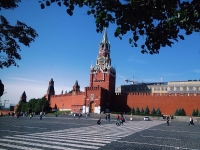
The Kremlin
The Moscow Kremlin is a fortress surrounded by a thick red wall, intersped with towers built in the late 15th century. It consists of golden-domed churches, palaces and museums, al
The Kremlin
The Moscow Kremlin is a fortress surrounded by a thick red wall, intersped with towers built in the late 15th century. It consists of golden-domed churches, palaces and museums, along with offices, assembly halls and monuments.
Cathedral Square is the religious centre of Moscow and the historic heart of the Kremlin. The attractive Annunciation Cathedral contains beautifully painted murals and icons on the interior walls. The throne of Ivan the Terrible can be found in the Cathedral of the Assumption, whose richly-coloured interior is lined with the tombs of many Russian Orthodox leaders.
The Belfry of Ivan the Great is the tallest structure within the walls. At its foot lies one of the world's biggest bells which was broken from a fall in 1701, while nearby is one of the world's largest cannons, the Tsar Cannon.
The Armoury Palace is the richest and oldest museum, housing a staggering collection gathered over the years by the Church and Russian state. These include jewel-studded coronation capes; thrones encrusted with diamonds; royal coaches and sleighs; and the renowned jewelled Faberge eggs, each containing an exquisitely detailed miniature object of precious metal. The Diamond Fund Exhibition in the same building contains the 180-carat diamond given to Catherine the Great by Count Orlov.
Website www.kreml.ru/en
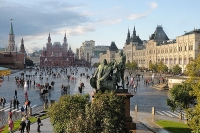
Red Square
Red Square is a dramatic cobbled square in the centre of Moscow. Originally the city's marketplace, the square also served as a public gathering place to celebrate festivals, liste…
Red Square
Red Square is a dramatic cobbled square in the centre of Moscow. Originally the city's marketplace, the square also served as a public gathering place to celebrate festivals, listen to government announcements or witness executions. The Soviets turned it into a memorial, constructing Lenin's Mausoleum on one side wherein his cadaver is still open for public viewing. St Basil's Cathedral is the square's most well-known building, crowned by the bulbous multi-coloured domes for which it is so famous. The communist government destroyed several ancient buildings around Red Square, with the current Resurrection Gate and Chapel both replicas built in the 1990s. The name originally meant 'beautiful', referring to St Basil's Cathedral at the southern end. But the word changed to mean 'red' too, giving the square its present name.
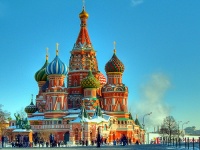
St Basil's Cathedral
St Basil's Cathedral is the most famous landmark in Russia, standing on the edge of Moscow's Red Square. Its striking design was commissioned by Ivan the Terrible to commemorate a …
St Basil's Cathedral
St Basil's Cathedral is the most famous landmark in Russia, standing on the edge of Moscow's Red Square. Its striking design was commissioned by Ivan the Terrible to commemorate a victorious military campaign against the Tartar Mongols in 1552. It's said that Ivan was so overwhelmed by its beauty that he had the architect blinded to prevent any rival creations. St Basil's includes a central chapel surrounded by eight tower-like chapels, each crowned with a different coloured and uniquely-patterned onion-shaped dome. The church escaped demolition many times, with the Soviets eventually closing it and later turning it into a museum. The interior is a dimly lit maze of corridors and delicately decorated chapels, with a priceless 16th century screen shielding the inner sanctuary.
Opens 11am to 5pm in winter, and 10am to 7pm in summer.
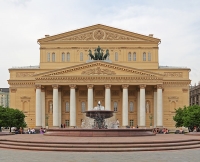
Bolshoi Opera and Ballet Theatre
Moscow's oldest and most famous theatre, the Bolshoi is home to world-renowned opera and ballet companies. Rebuilt after a fire in 1856, the grand building is a masterpiece of Russ…
Bolshoi Opera and Ballet Theatre
Moscow's oldest and most famous theatre, the Bolshoi is home to world-renowned opera and ballet companies. Rebuilt after a fire in 1856, the grand building is a masterpiece of Russian neoclassicism, including an eight-columned entrance porch topped by the horse-drawn chariot of Apollo. The glittering five-tiered interior is richly adorned with red velvet furnishings, ornate gold detailing and chandeliers, while the size of the auditorium makes it one of the largest theatres in the world. The Bolshoi Theatre has hosted some of the world's most celebrated premieres, such as Swan Lake, Spartacus and concerts by Wagner.
Website www.bolshoi.ru/en
Opens 11am to 8pm
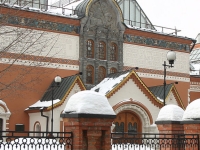
Tretyakov Gallery
The Tretyakov Gallery houses some of the great masterpieces of traditional Russian art from before the Revolution and has the world's finest collection of Russian icons dating from…
Tretyakov Gallery
The Tretyakov Gallery houses some of the great masterpieces of traditional Russian art from before the Revolution and has the world's finest collection of Russian icons dating from the 11th to the 17th-century. The gallery's collection of paintings, graphics and sculptures covers Russian art from the 18th to the 20th century. The gallery was named after its founder, Pavel Tretyakov, an art collector who donated about 2,000 works of art from his private collection to the city of Moscow, forming the basis of the collection to which state acquisitions were later added. He also donated his own residence, which became the original site of the art gallery. Two separate buildings at different locations house the works selected for display.
Website www.tretyakovgallery.ru/en
Opens Tuesday, Wednesday, and Sunday: 10am to 6pm. Thursday, Friday, Saturday: 10am to 9pm
Admission
Adults: RUB 500. Minors enter for free
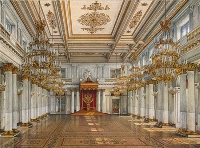
The Winter Palace and the Hermitage Museum
At 656 foot-long (200m), the Winter Palace is the biggest and most lavishly decorated in the city. Once the official residence of the tsars, Catherine the Great added the Small and…
The Winter Palace and the Hermitage Museum
At 656 foot-long (200m), the Winter Palace is the biggest and most lavishly decorated in the city. Once the official residence of the tsars, Catherine the Great added the Small and Large Hermitages as a sanctuary for herself and her private art collection. The Hermitage Museum comprises a stately complex of buildings strung along the embankment, with the Winter Palace at its heart. Its collection has grown to contain more than three million pieces, its three floors covering from ancient times and modern art to works by the Impressionists and Post-Impressionists. A rich interior is bedecked with elaborate mosaics, alongside white marble staircases, golden ceilings and crystal chandeliers.
Website www.hermitagemuseum.org
Opens Wednesday, Friday: 10.30am to 9pm. Tuesday, Thursday, Saturday, Sunday: 10.30am to 6pm
Admission
Full access: RUB 700
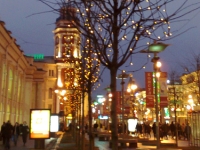
Nevsky Prospekt
Almost three miles (5km) long, Nevsky Prospekt is one of the best-known streets in Russia and the main thoroughfare of St Petersburg. It starts at the gilded spire of the Admiralty…
Nevsky Prospekt
Almost three miles (5km) long, Nevsky Prospekt is one of the best-known streets in Russia and the main thoroughfare of St Petersburg. It starts at the gilded spire of the Admiralty Building, passing both the Moscow Railway Station and the Alexander Nevsky Monastery. The hub of St Petersburg for centuries, it cuts through the most important segment of the city. Intersected by rivers and canals, the most beautiful part of the avenue surrounds the Griboyedov Canal. The grand Kazan Cathedral catches the eye, as does the breathtaking onion domes of the Church of Our Saviour on the Spilled Blood. Modelled on St Basil's in Moscow it's adorned with exquisite mosaic panels. Aside from the many places of worship, the street also boasts St Petersburg's finest shops and restaurants.
Website www.nevsky-prospekt.com
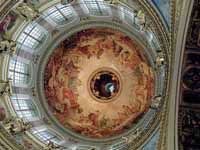
St Isaac's Cathedral
The golden dome of St Isaac's Cathedral dominates the skyline of St Petersburg, with the colonnade around the cupola offering superb panoramic views over the city. Commissioned by …
St Isaac's Cathedral
The golden dome of St Isaac's Cathedral dominates the skyline of St Petersburg, with the colonnade around the cupola offering superb panoramic views over the city. Commissioned by Tsar Alexander I to be a magnificent imperial cathedral, the ensuing masterpiece was of grandiose proportions which took more than 40 years to build. It was decorated in the most extravagant manner, incorporating many different kinds of stone and marble work. The Russian Classic exterior encloses a splendid interior adorned with red granite columns, exquisite mosaics and painted ceilings, along with sculptures, frescoes and a beautiful stained-glass window. The cathedral can accommodate 14,000 worshippers, and no photography or filming is allowed.
Website eng.cathedral.ru
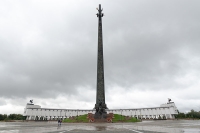
Poklonnaya Hill
Historically, Poklonnaya Hill was a spot for Westerners to pay homage to Moscow before entering. Today, it's a beacon to Russia's military strength, having withstood invasions by b…
Poklonnaya Hill
Historically, Poklonnaya Hill was a spot for Westerners to pay homage to Moscow before entering. Today, it's a beacon to Russia's military strength, having withstood invasions by both Napoleon and Hitler. Atop the hill is Victory Park, providing a scenic walk and contains a memorial mosque and synagogue for victims of the war, and an open air museum dedicated to the victory over Napoleon. There are many tanks and other wartime vehicles on display in Victory Park, along with several impressive monuments and statues. History buffs will love exploring the many attractions of Poklonnaya Hill and Victory Park, and even those not interested in military history will enjoy the art and the views.
Website www.poklonnaya-gora.ru/en
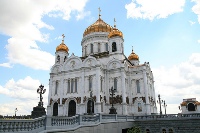
Cathedral of Christ the Saviour
After Napoleon retreated from Russia, Tsar Alexander I declared that a cathedral be built in remembrance of the soldiers who had died defending Mother Russia. The original cathedra…
Cathedral of Christ the Saviour
After Napoleon retreated from Russia, Tsar Alexander I declared that a cathedral be built in remembrance of the soldiers who had died defending Mother Russia. The original cathedral took more than 40 years to build. Decades later the cathedral was demolished by Stalin to make way for the colossal Palace of the Soviets, which was never actually built. The Cathedral of Christ the Saviour was rebuilt again between 1990 and 2000 as a faithful duplicate of the original, currently serving as one of the largest and tallest Orthodox Churches in the world. The contemporary Russian artwork, statues and memorials to the Russian tsars, as well as a small indoor museum, are well worth a look.
Website russiau.com/cathedral-christ-saviour-moscow/
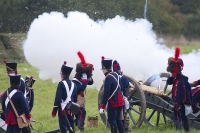
Borodino Panorama Museum
The battle of Borodino is regarded as the bloodiest of the Napoleonic battles, seeing over 70,000 casualties in a single day and leading Napoleon to brand the Russians 'invincible'…
Borodino Panorama Museum
The battle of Borodino is regarded as the bloodiest of the Napoleonic battles, seeing over 70,000 casualties in a single day and leading Napoleon to brand the Russians 'invincible'. The Borodino Panorama Museum was inaugurated in 1960, with a collection of wartime memorabilia on one level and the enormous panorama on another. The panorama isn't an outdoor view but a 360 degree painting by Franz Roubaud depicting a crucial moment in the battle itself. The mural is 115 meters long and 15 meters high. The museum will delight military history buffs, but should also impress the uninitiated. Those with smartphones can download the museum's interesting audio guide, helped along by free wifi.
Website www.1812panorama.ru/english.html
Opens Saturday to Wednesday: 10am to 6pm. Thursday: 10am to 9pm. Closed on Fridays.
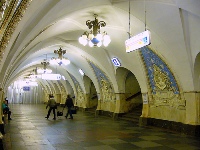
Moscow Metro
Moscow's metro stations amount to the most beautiful public transport facilities in the world. Visitors should not miss taking a ride on this glorious underground rail system, each…
Moscow Metro
Moscow's metro stations amount to the most beautiful public transport facilities in the world. Visitors should not miss taking a ride on this glorious underground rail system, each station boasting a distinct aesthetic, variously adorned with Realist artworks, chandeliers, ornate pillars and marble floors. They are more akin to palaces or five-star hotel lobbies than functional spaces, with the depth of the elevators also astounding. Most travellers in Moscow will encounter the metro system for practical reasons, but many will find that they choose to spend more time than necessary underground. There are nearly 200 stations but some of the most beautiful and ornate are Kievskaya, Dostoyevskaya and Prospekt Mira, along with Mayakovskaya and Ploshchad Revolyutsii.
Website engl.mosmetro.ru
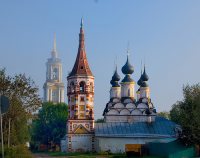
Golden Ring
Consisting of a circuit of historic cities northeast of Moscow, the Golden Ring is a popular tourist route for travellers in Russia. The cities are popular for their distinctive ar…
Golden Ring
Consisting of a circuit of historic cities northeast of Moscow, the Golden Ring is a popular tourist route for travellers in Russia. The cities are popular for their distinctive architecture and tradition of handmade craftsmanship, offering tourists a good opportunity to buy beautiful Russian souvenirs. The cities are fairly similar so it isn't necessary to visit them all, with most travellers choosing to see only four or five. But one that shouldn't be missed is Sergiev Posad, the centre of the Russian Orthodox Church and home to the impressive Sergiev Posad Monastery. Suzdal is another highlight on any Golden Ring tour, home of the St Euthymius Monastery and the enormous Spaso-Evfimiev Monastery, which houses 10 museums and is nearly as impressive as St Basil's in Moscow.


